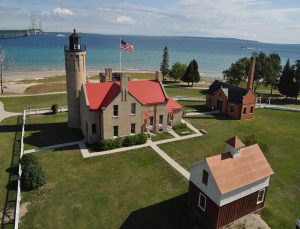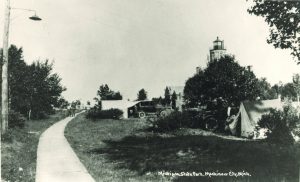
Today, visitors to Old Mackinac Point Lighthouse enter the site via the Fog Signal Building, constructed in 1906. The machinery originally housed inside powered fog whistles, and later air horns, to guide sailors during periods of poor visibility. The building itself, however, was only constructed after a 13-year legal dispute between the federal government and the Village of Mackinaw City.
The first building erected at Old Mackinac, in 1890, was a fog signal. The lighthouse itself was completed two years later, with Keeper George Marshall illuminating the beacon for the first time on October 25, 1892. Unfortunately for Marshall and his family, who had moved into the keepers’ quarters two days earlier, the 1890 fog signal proved uncomfortably close to their new home. The 10-inch steam whistles mounted on the fog signal’s roof were too close to the keepers’ quarters, which may also have blocked the sound to the west. Notified of the problem, the U.S. Lighthouse Service began to work on possible solutions.

By 1893, the Lighthouse Service prepared to purchase more land to the east for a new fog signal building, making an offer in July. The Village of Mackinaw City responded in January 1894, refusing to sell the land, which was part of a village park surrounding the lighthouse. For the next five years, the situation remained unresolved as the village continued to deny requests to purchase a portion of the park. In 1899, however, the Lighthouse Service opened condemnation proceedings on a portion of the park in the federal district court located in Bay City. A federal marshal visited Old Mackinac Point to gather evidence in August, and Keeper Marshall was called as a witness. The condemnation hearing continued into 1900. By 1901, although the condemnation proceedings continued, the federal government authorized a $400 payout to the village for taking the park land, as well as an additional $1,500 to cover damage to adjacent lands. Although authorized, these payments were apparently not made, and condemnation proceedings dragged on in the Bay City district court until August 1904, when the court awarded $400 to the village in return for the park property. However, the Treasury Department, which controlled the Lighthouse Service, responded that it did not have sufficient funds to cover the $400 payout. As a result, Lighthouse Service officials made an appeal directly to Congress for a $400 appropriation to cover the award costs.
Finally, the government made the $400 payout in 1905, clearing the way for a new fog signal building. Construction began in May 1906, as workers erected a new brick fog signal building to the east of the existing 1890 structure. The machinery inside was transferred to the new building, the new fog signal was operational by December. The old fog signal building was moved to the south edge of the light station property and turned into a warehouse, which remained until torn down in the 1940s.
The village park that Mackinaw City fought to maintain was transferred to the Mackinac Island State Park Commission in 1909, becoming Michilimackinac State Park, the second state park in Michigan. Today, you can stroll through the shoreline park free of charge, or visit the restored buildings at Old Mackinac Point (including the 1906 fog signal that caused so much legal trouble) for a small fee.









